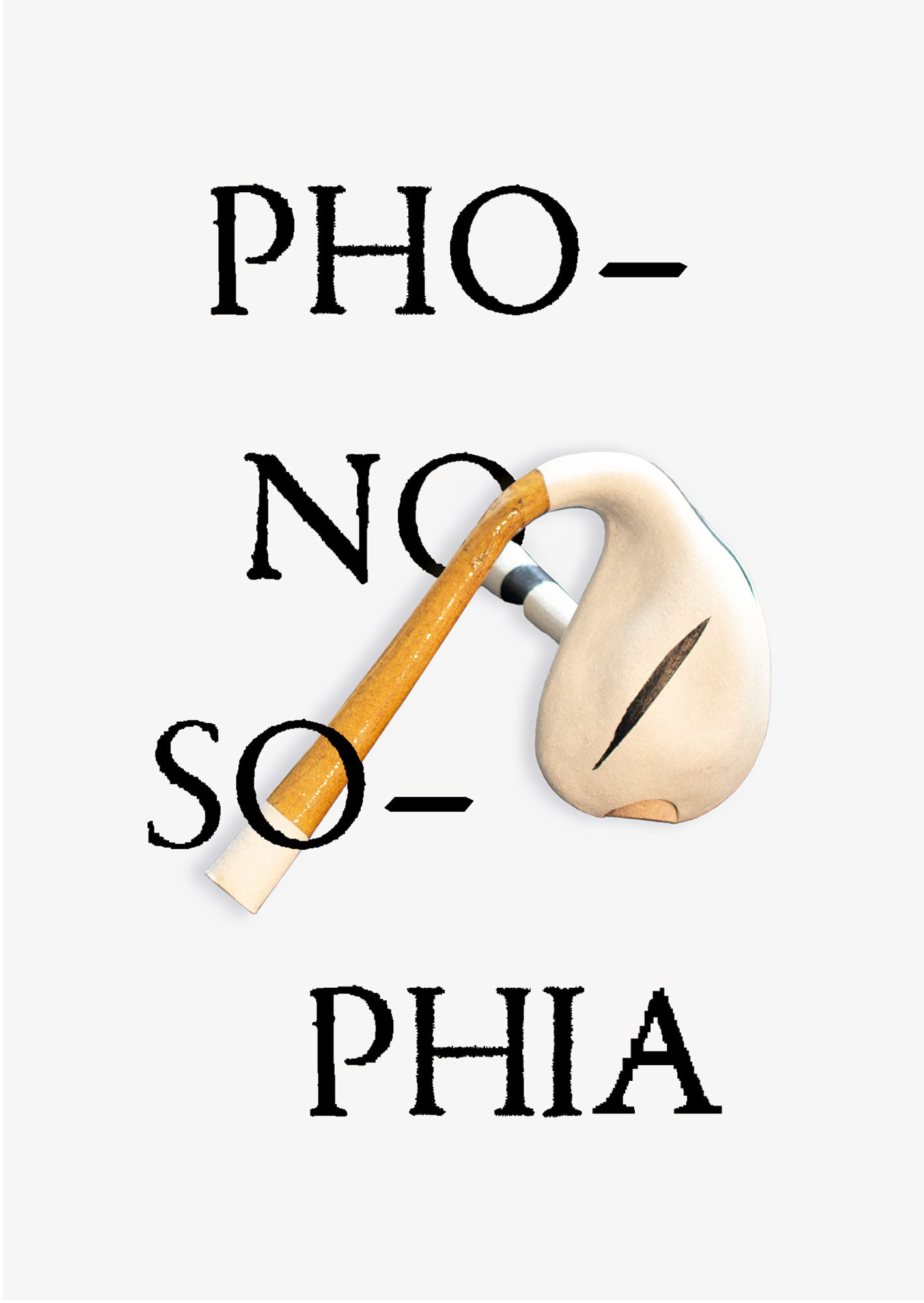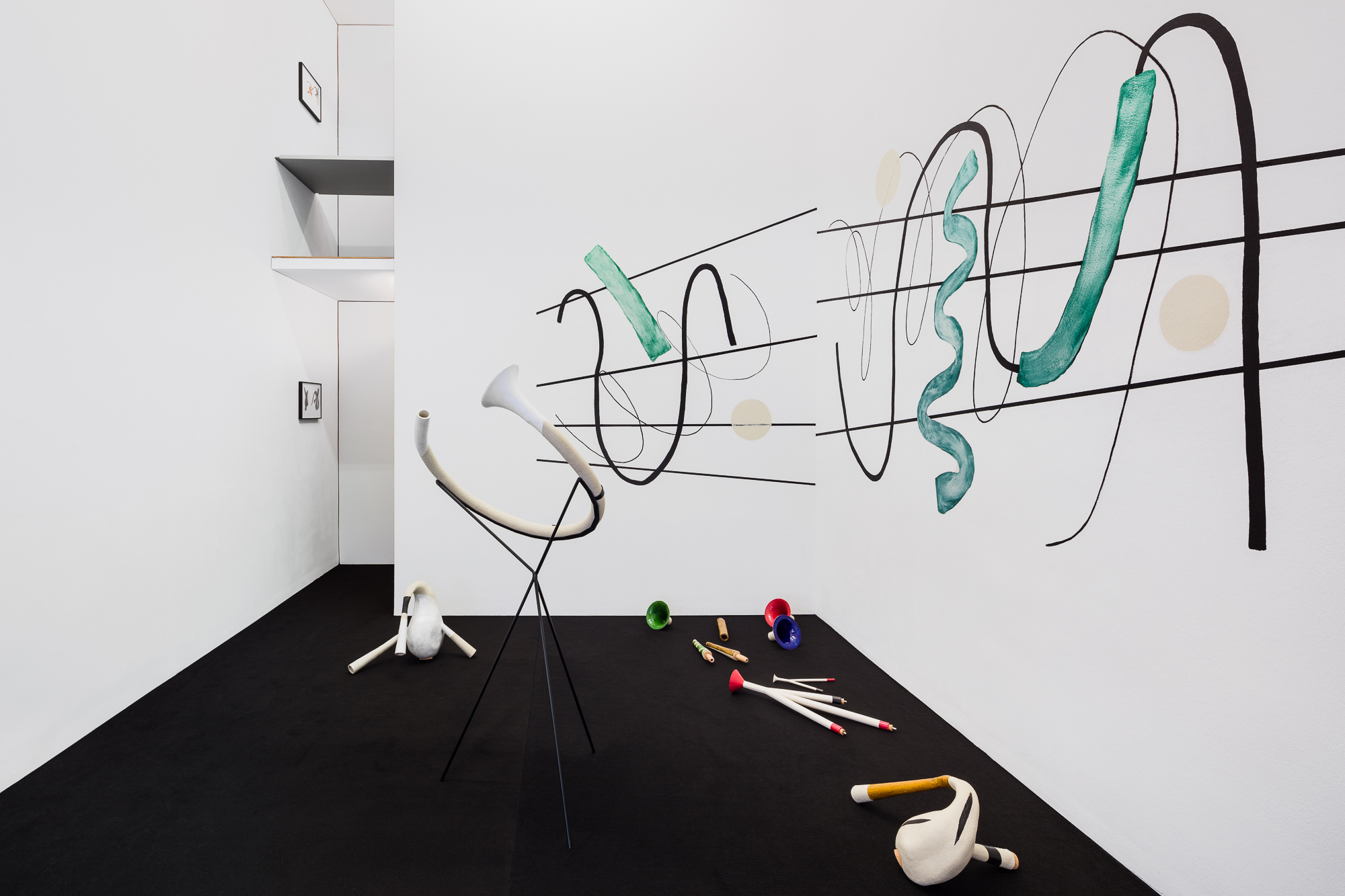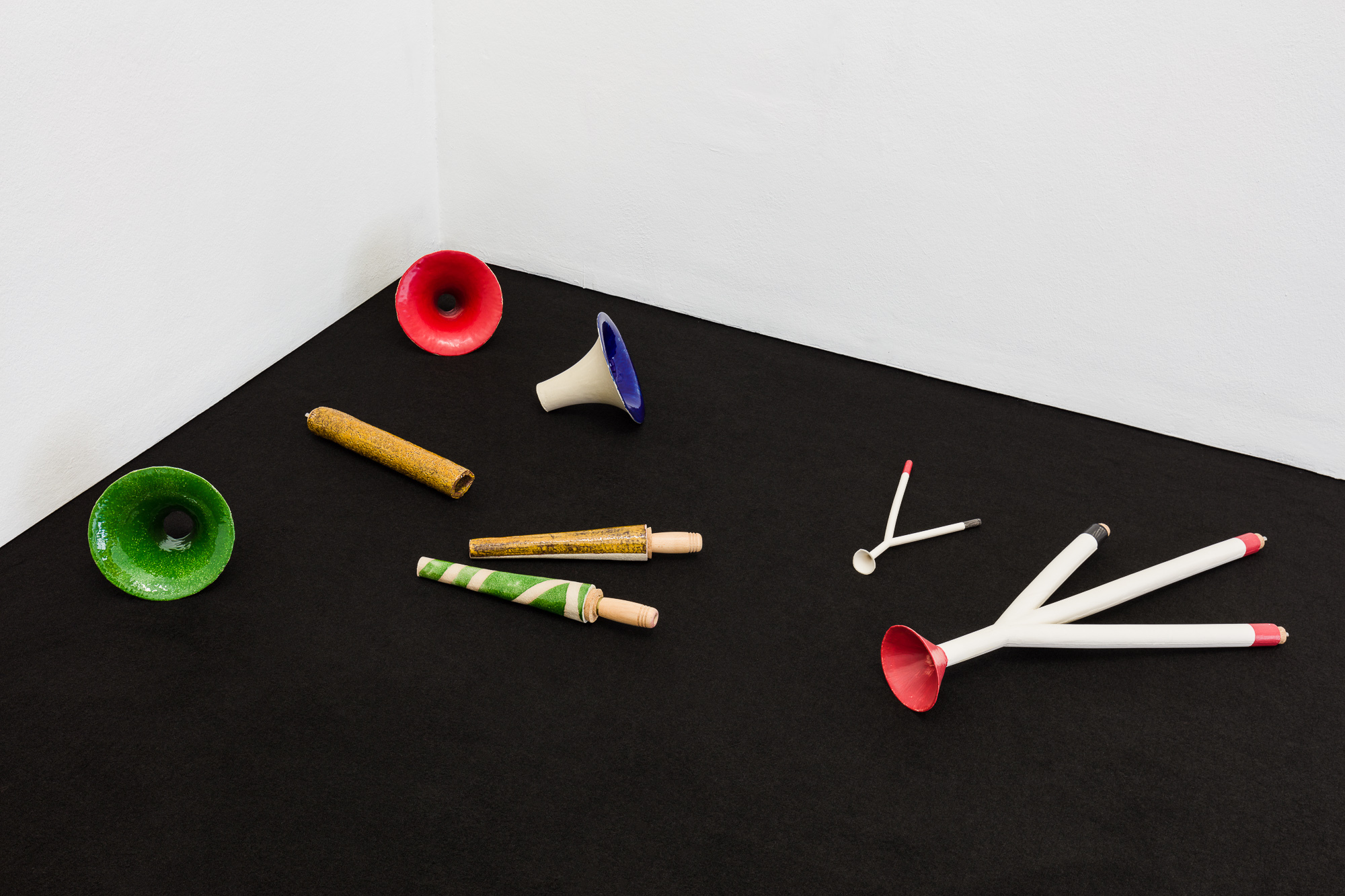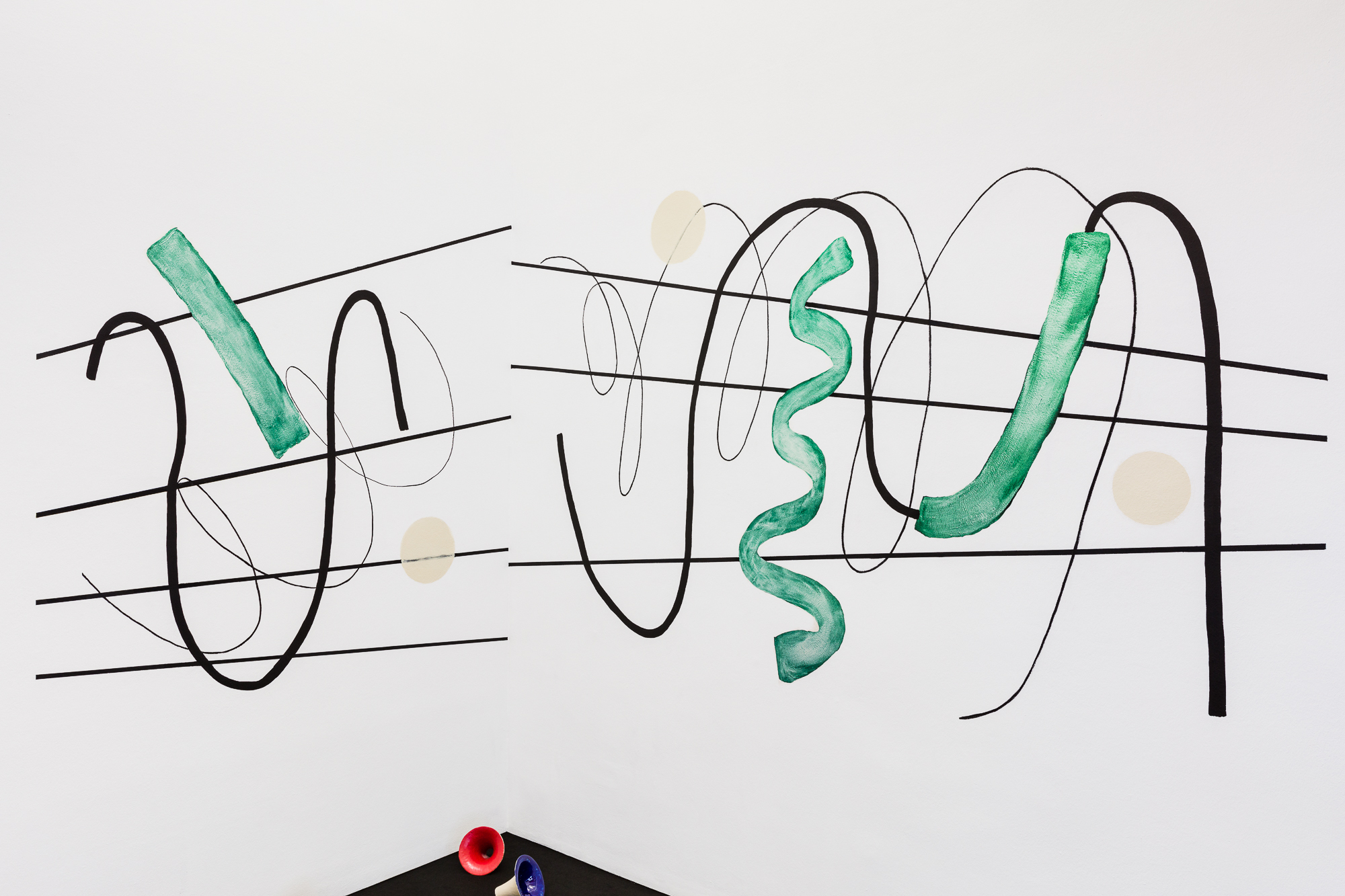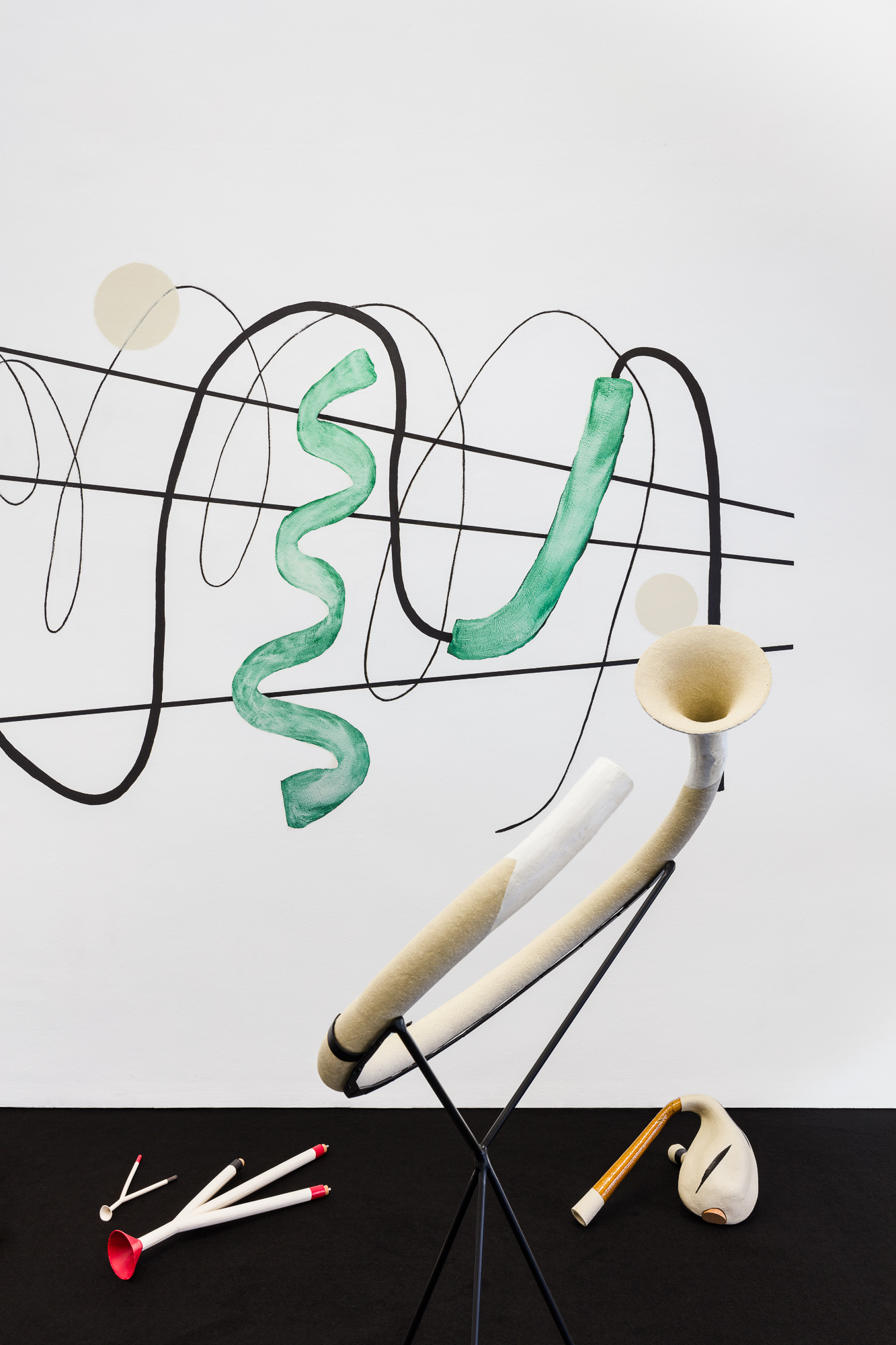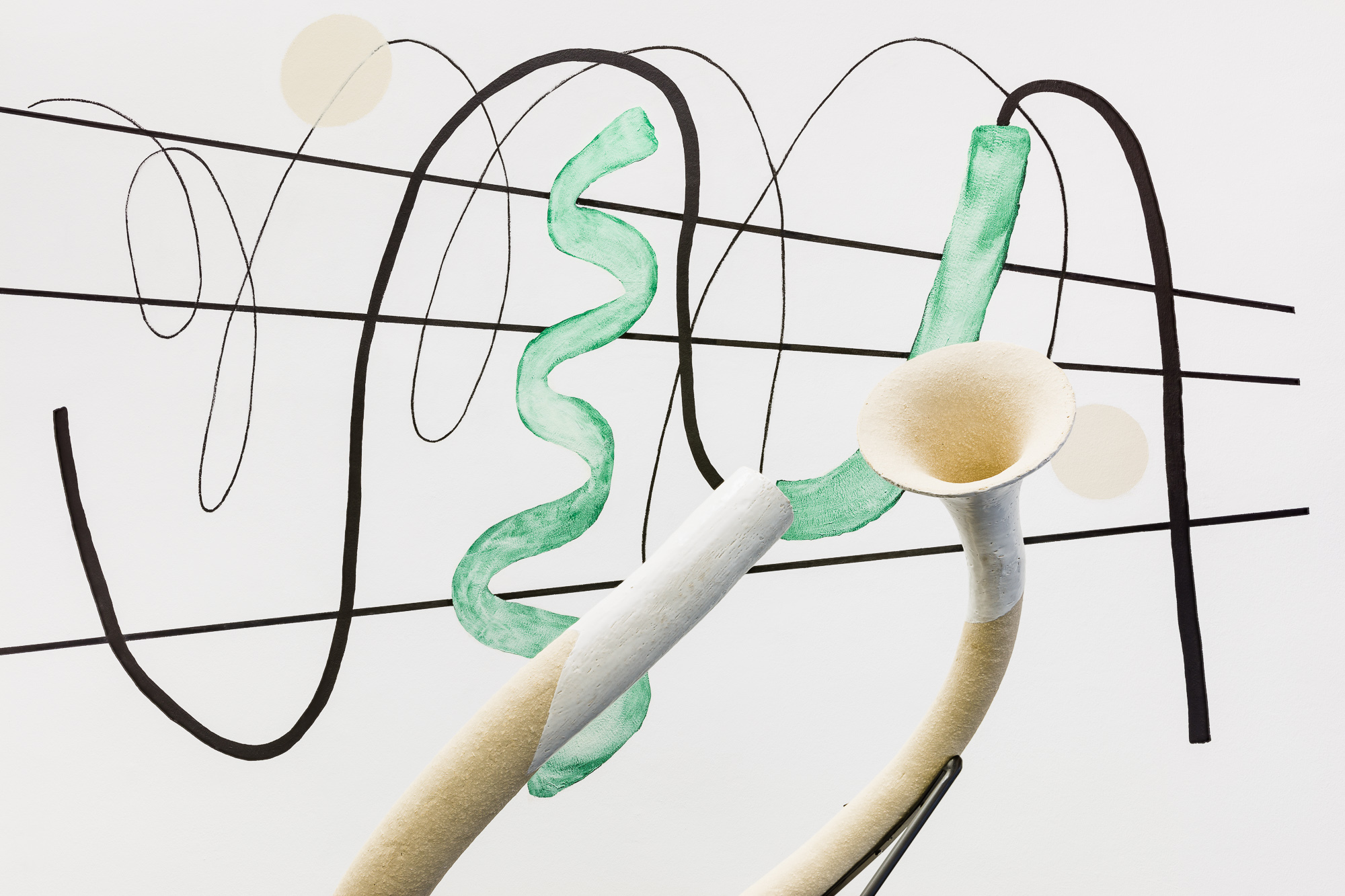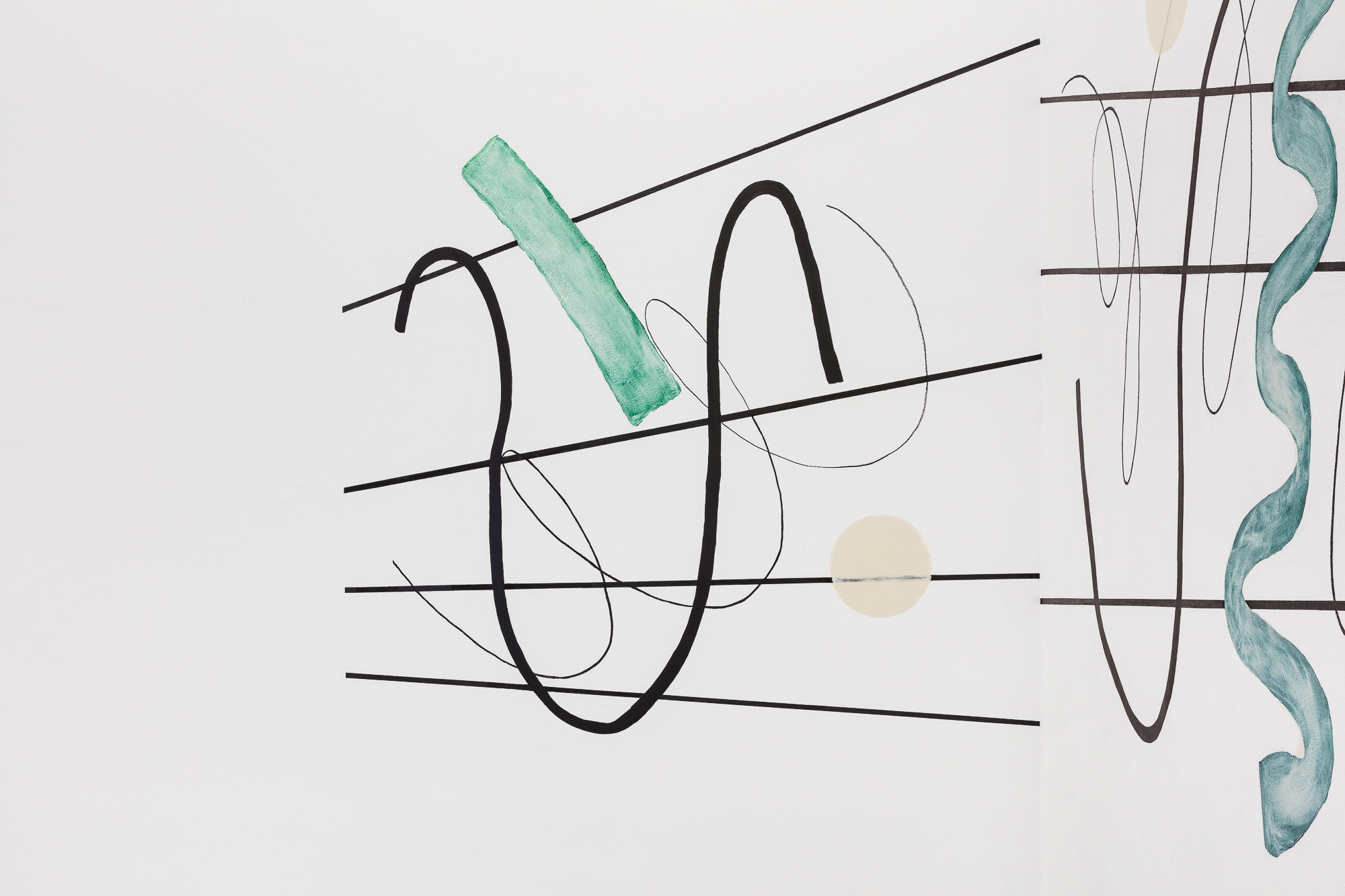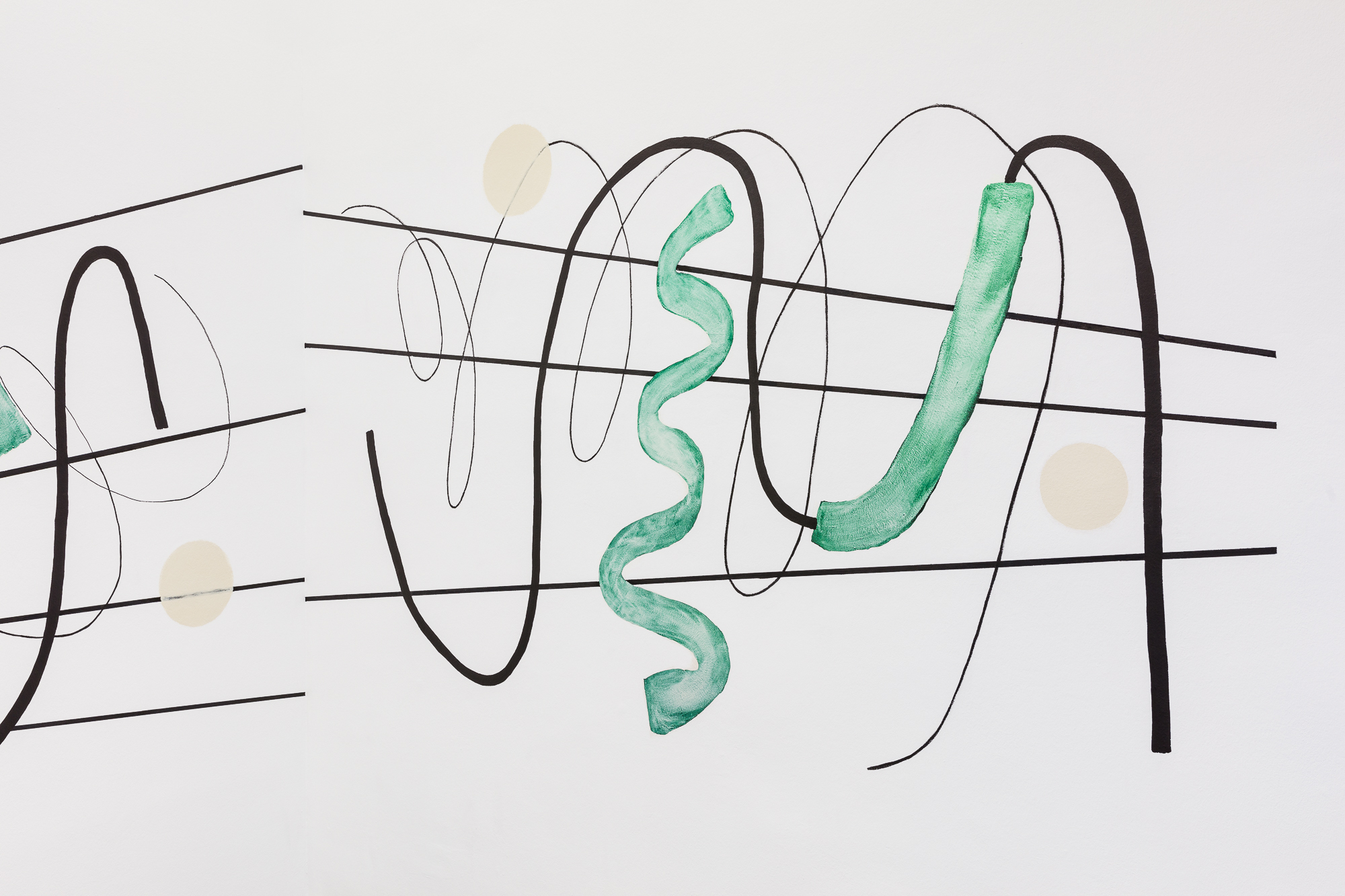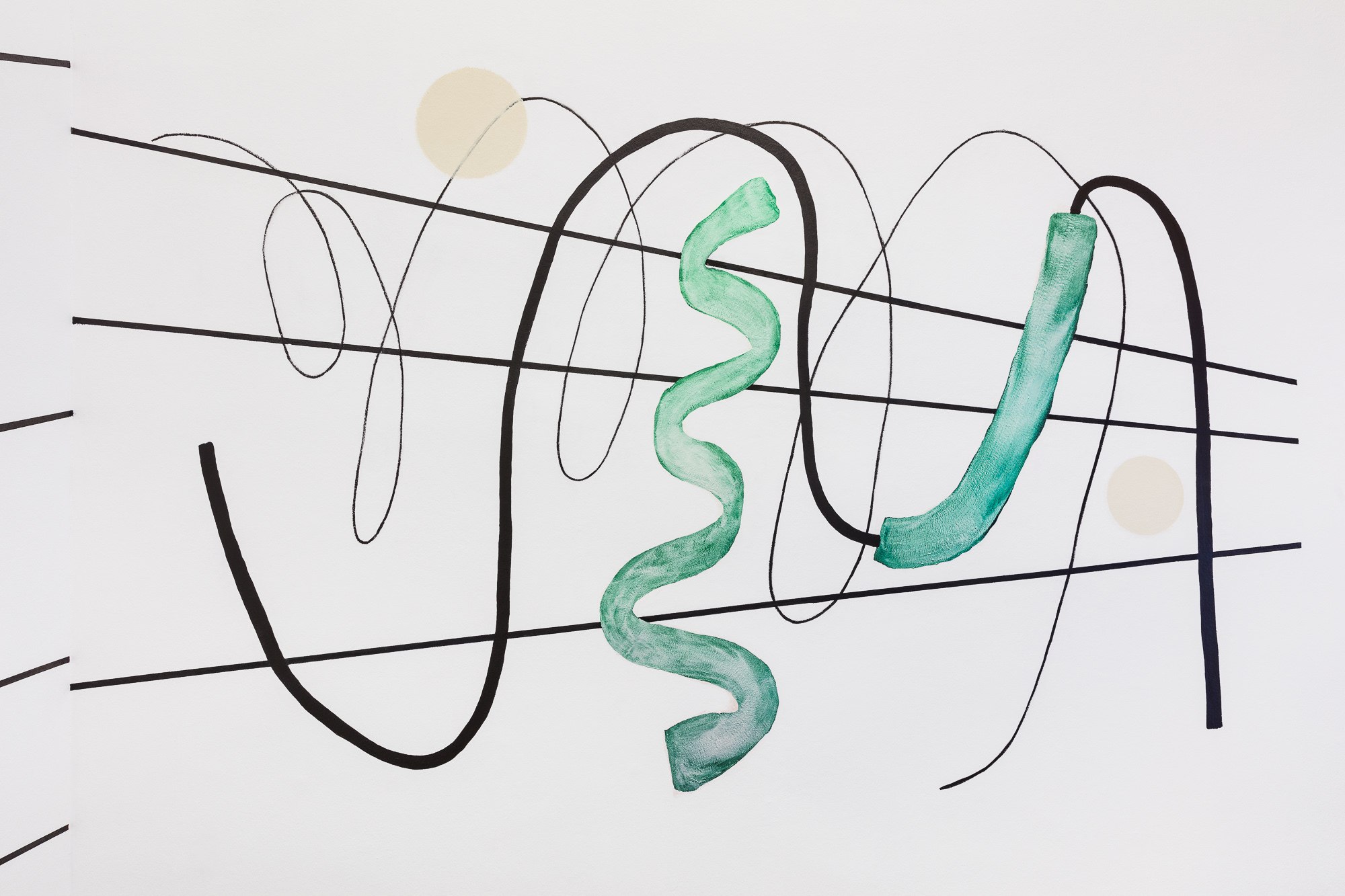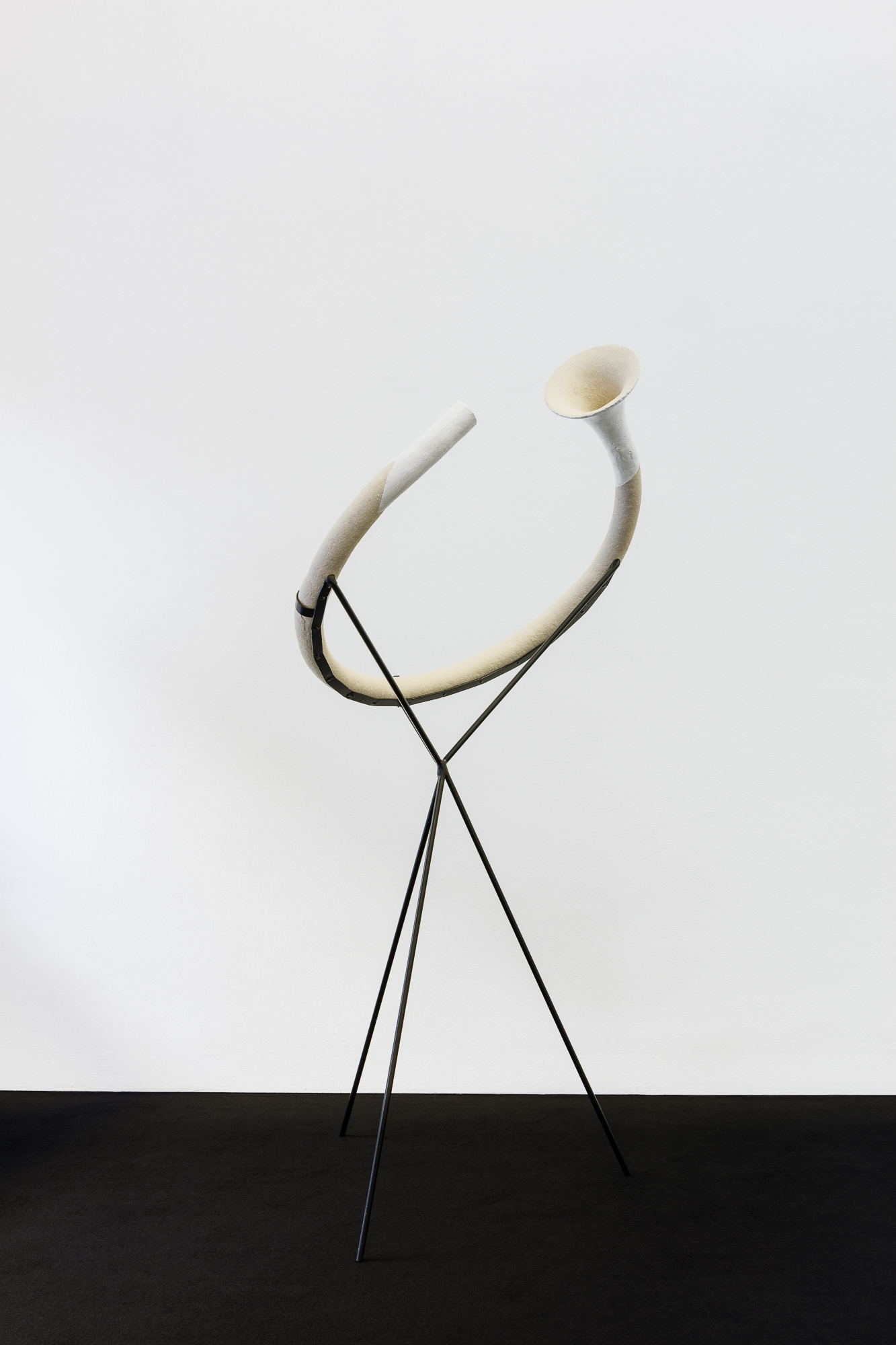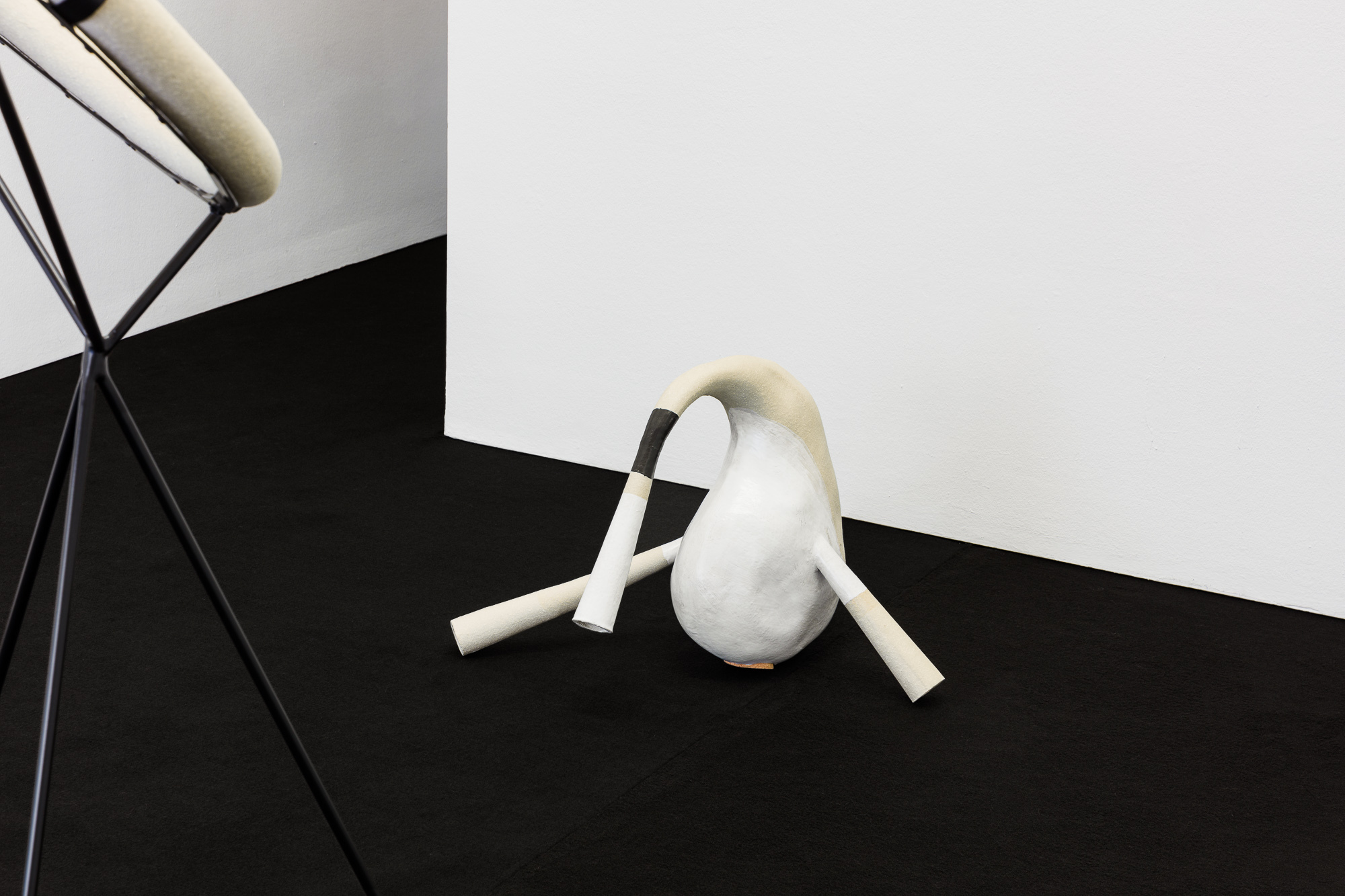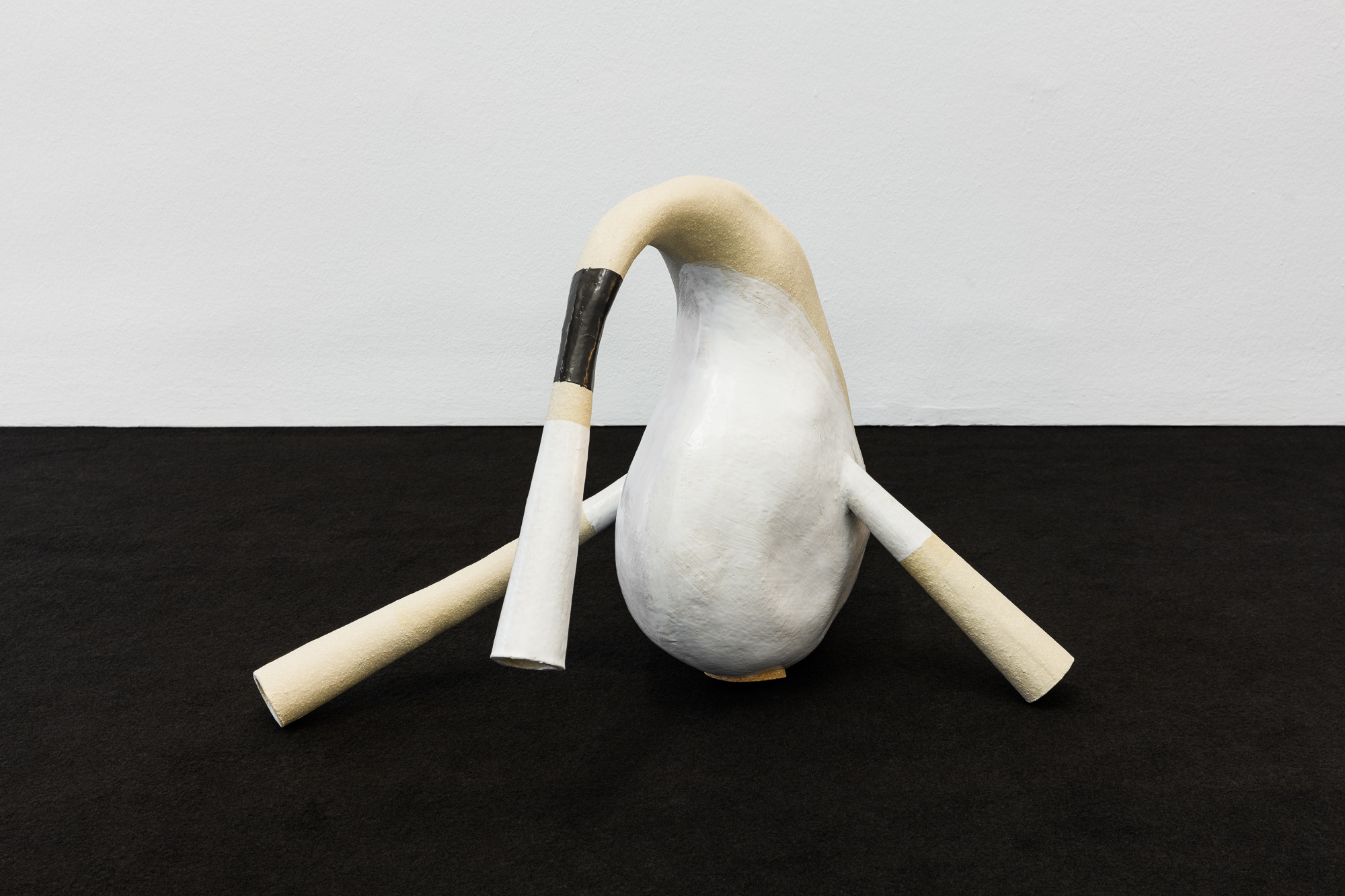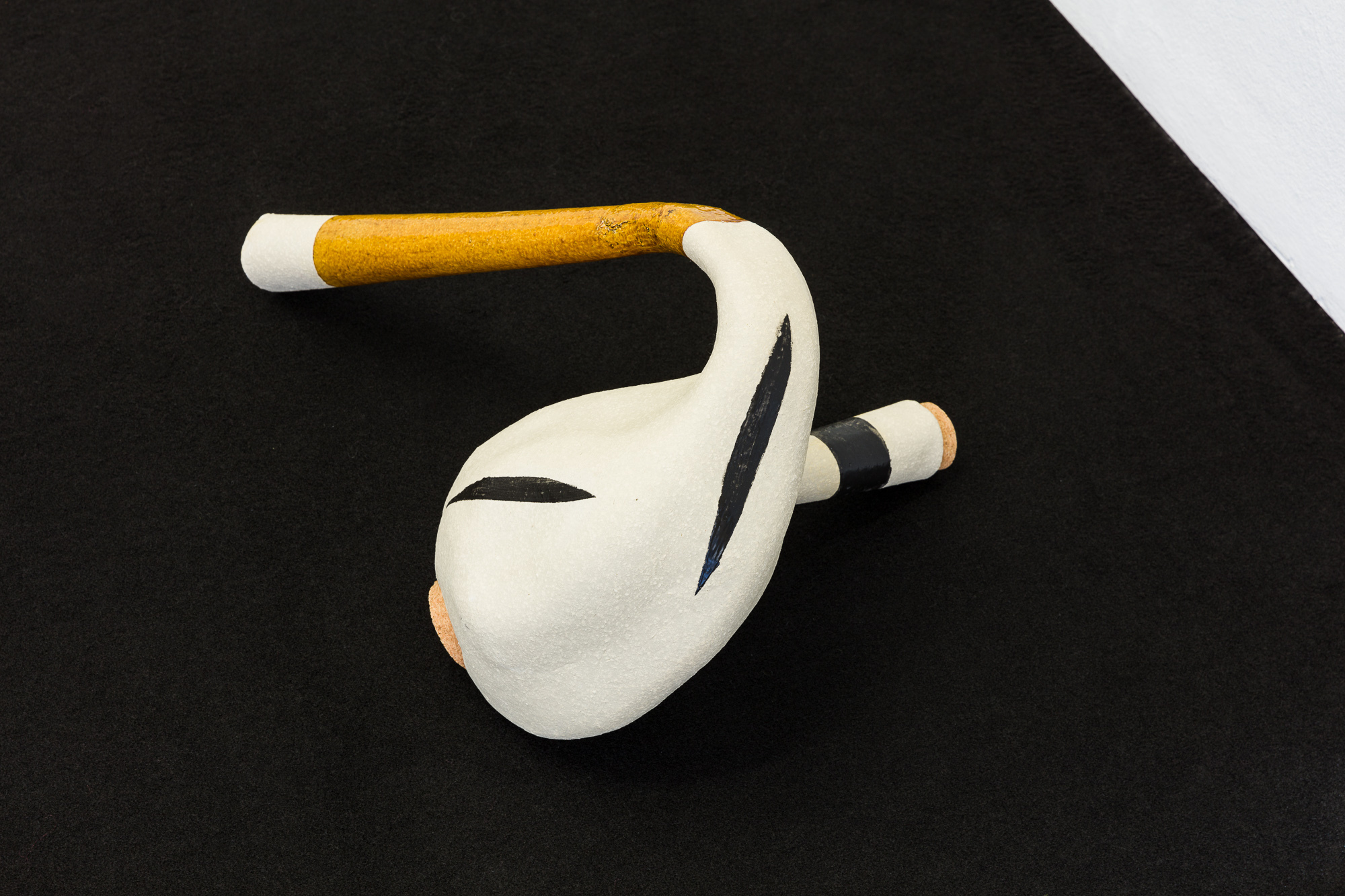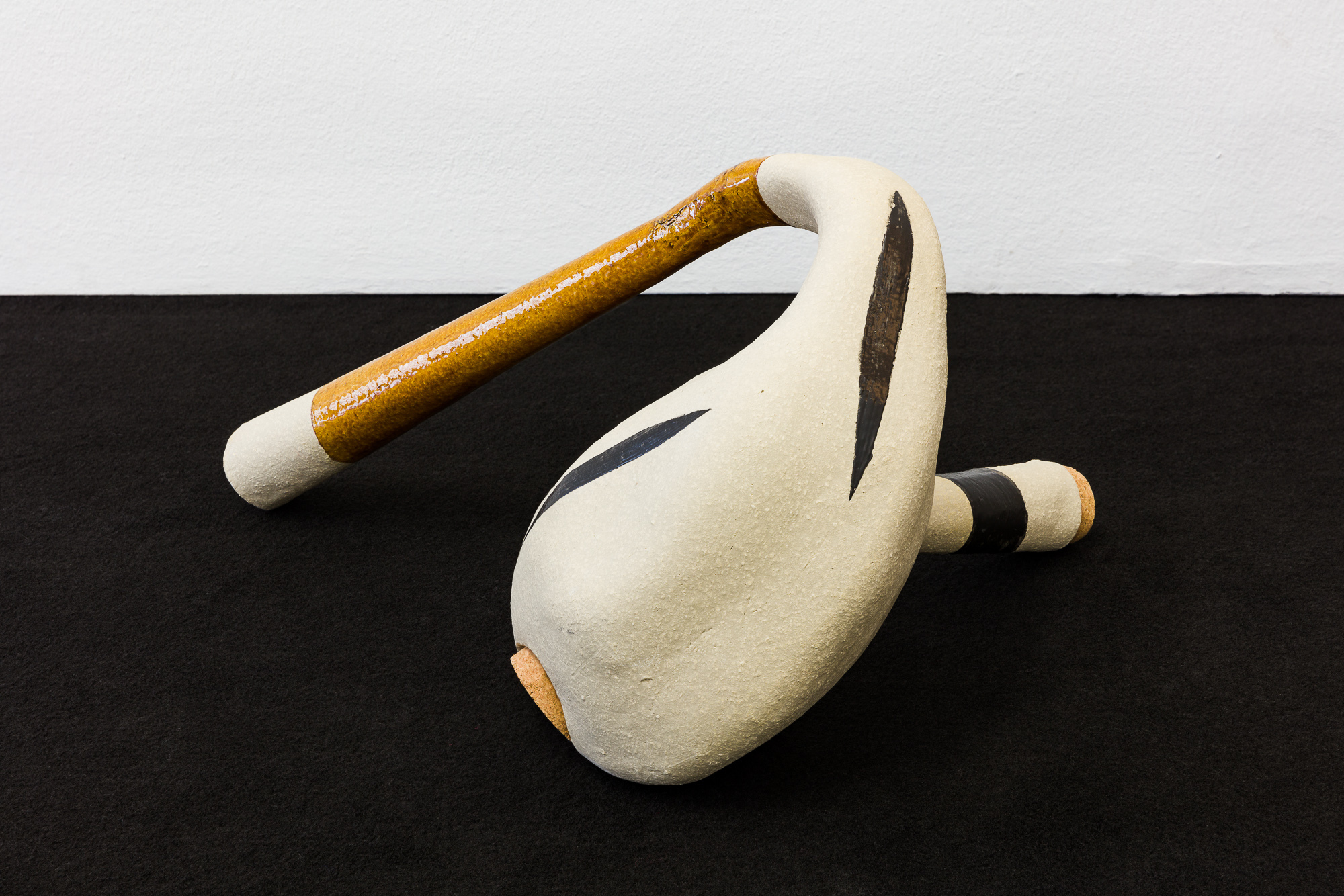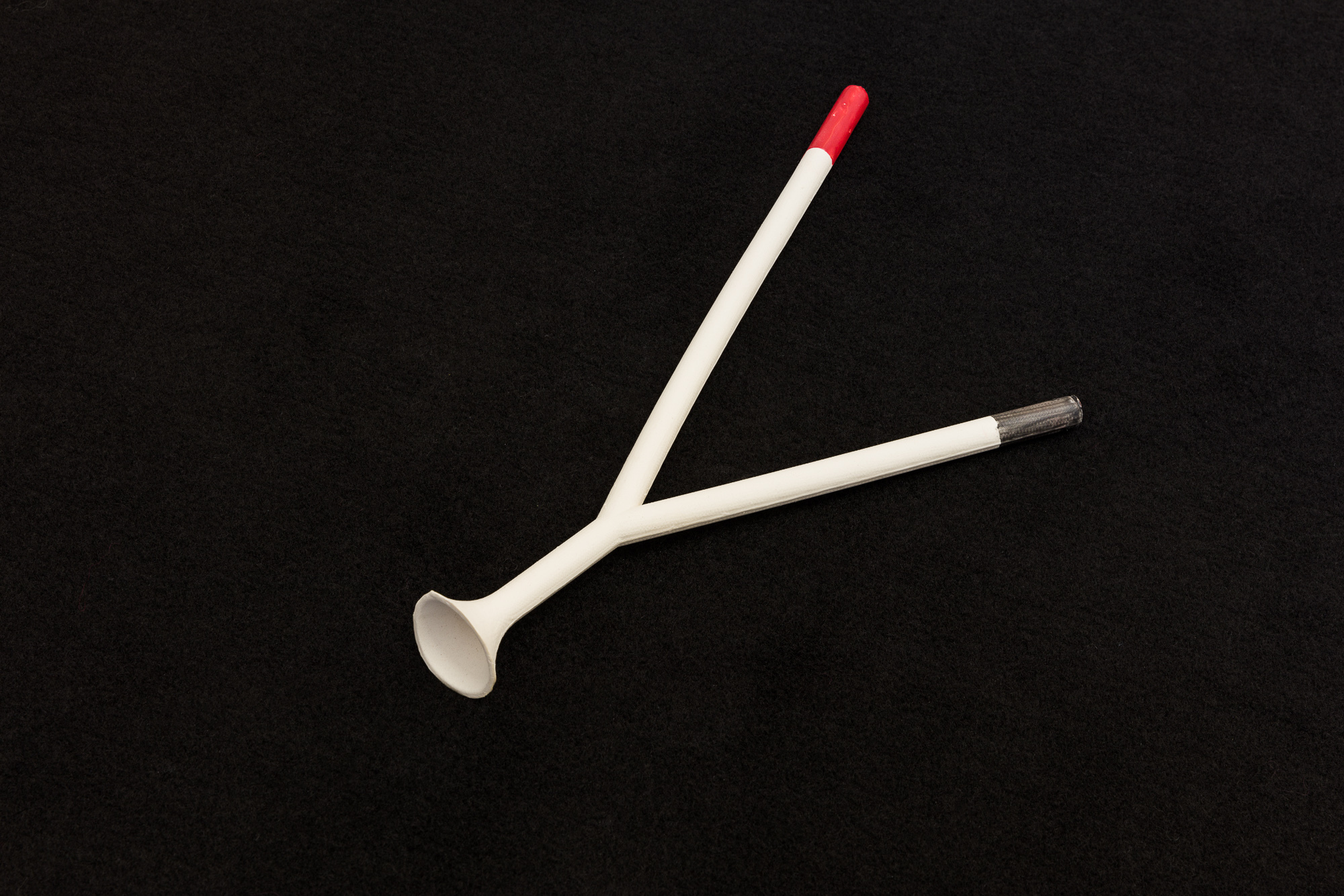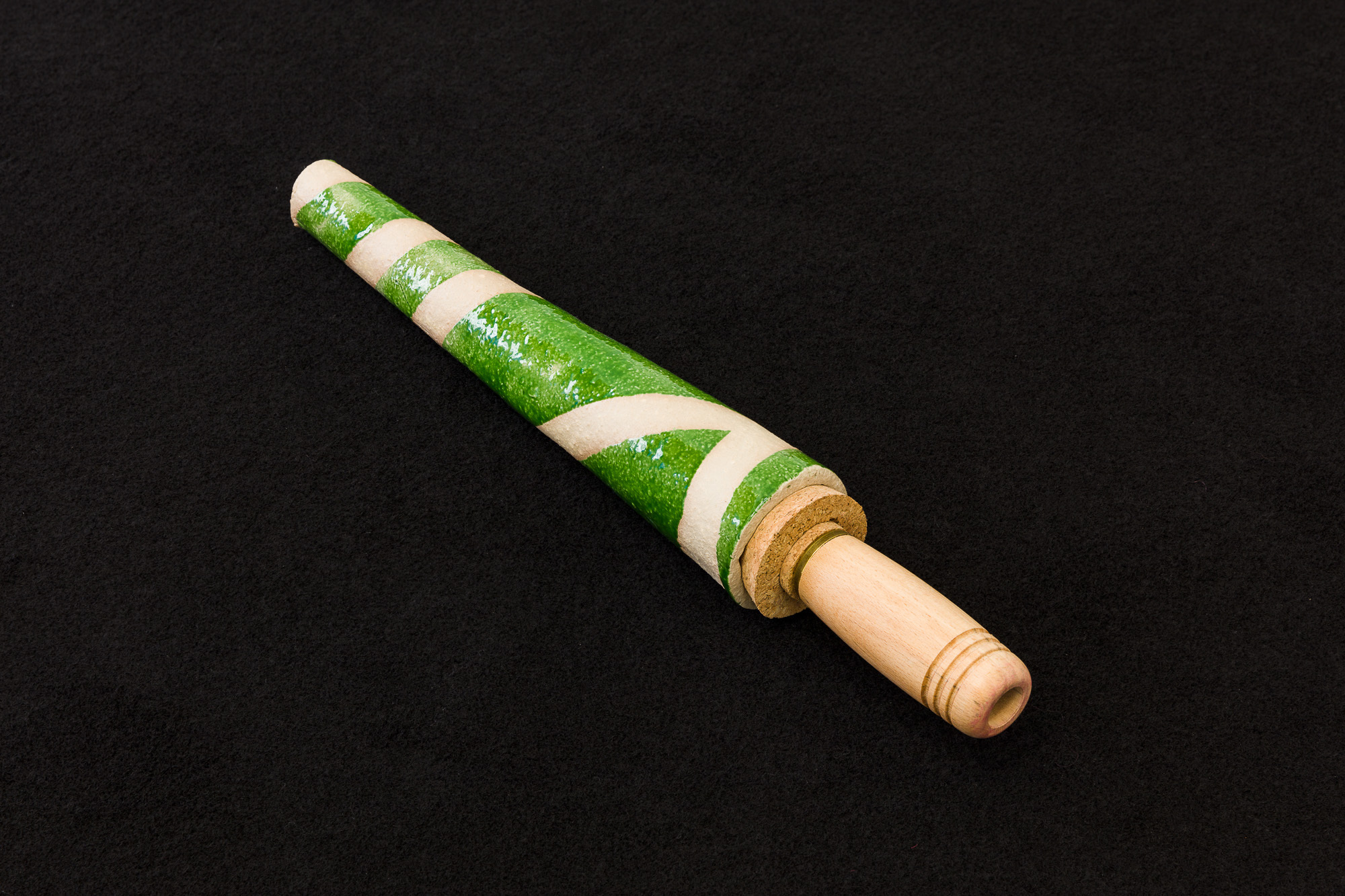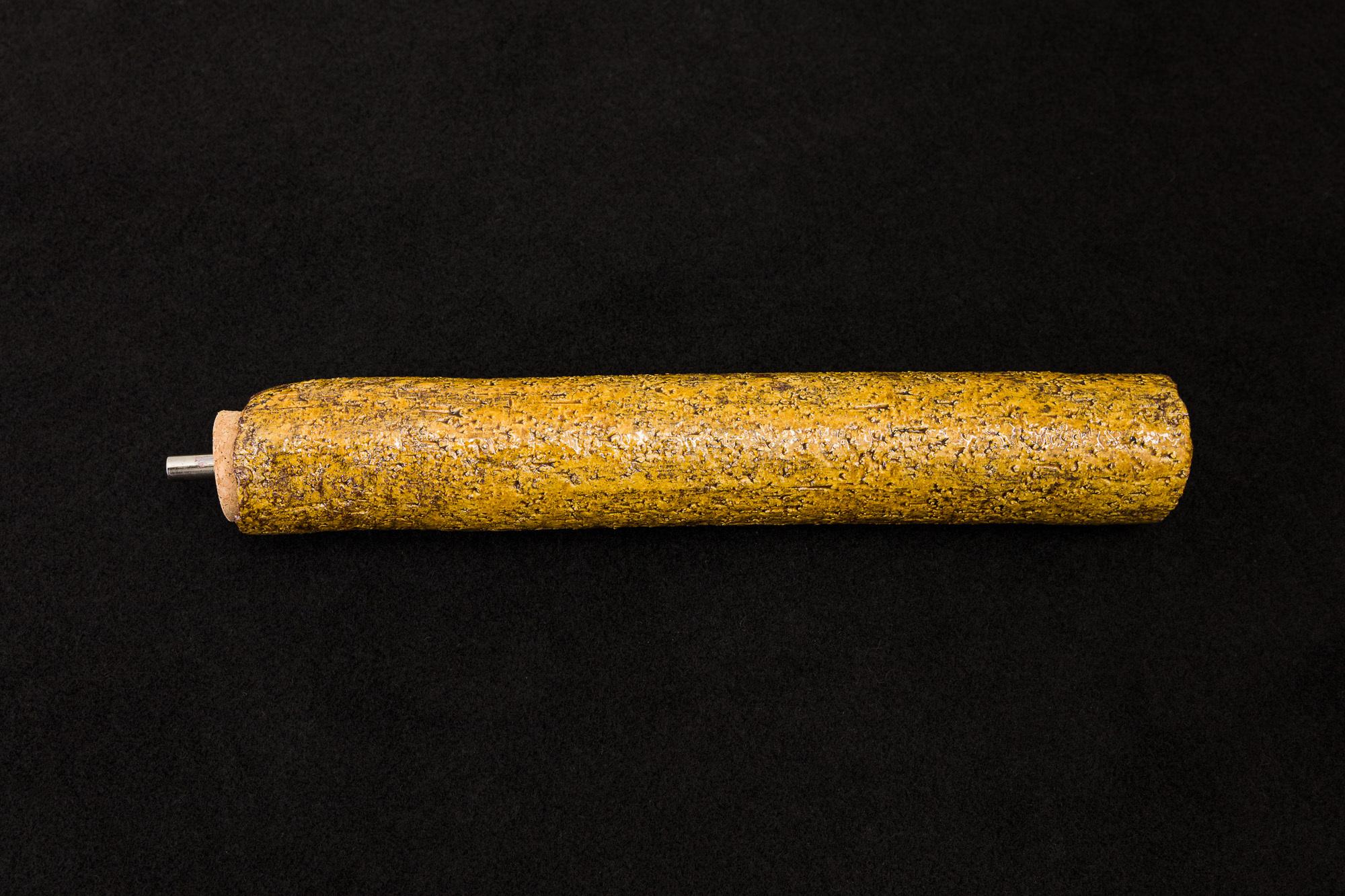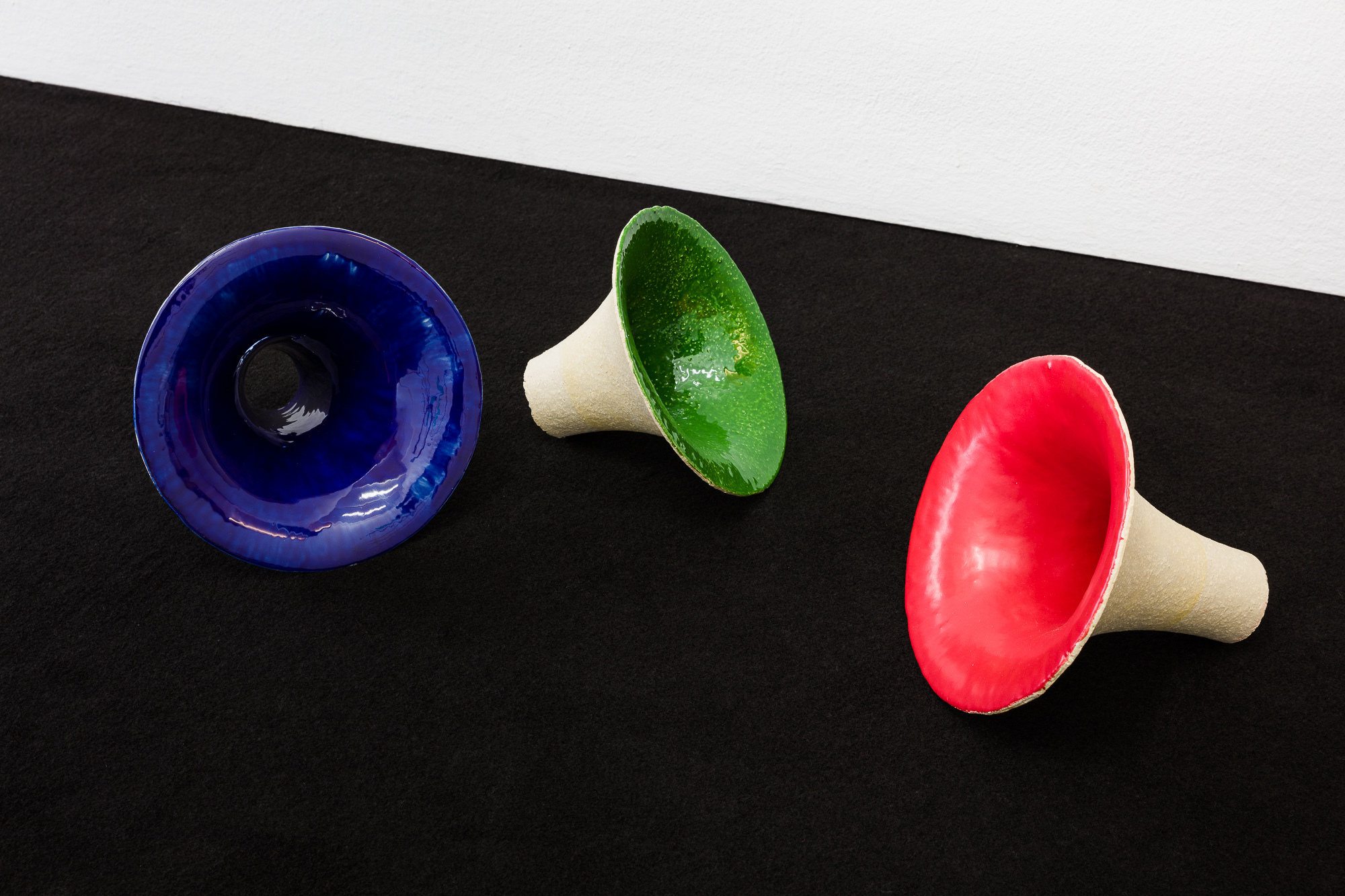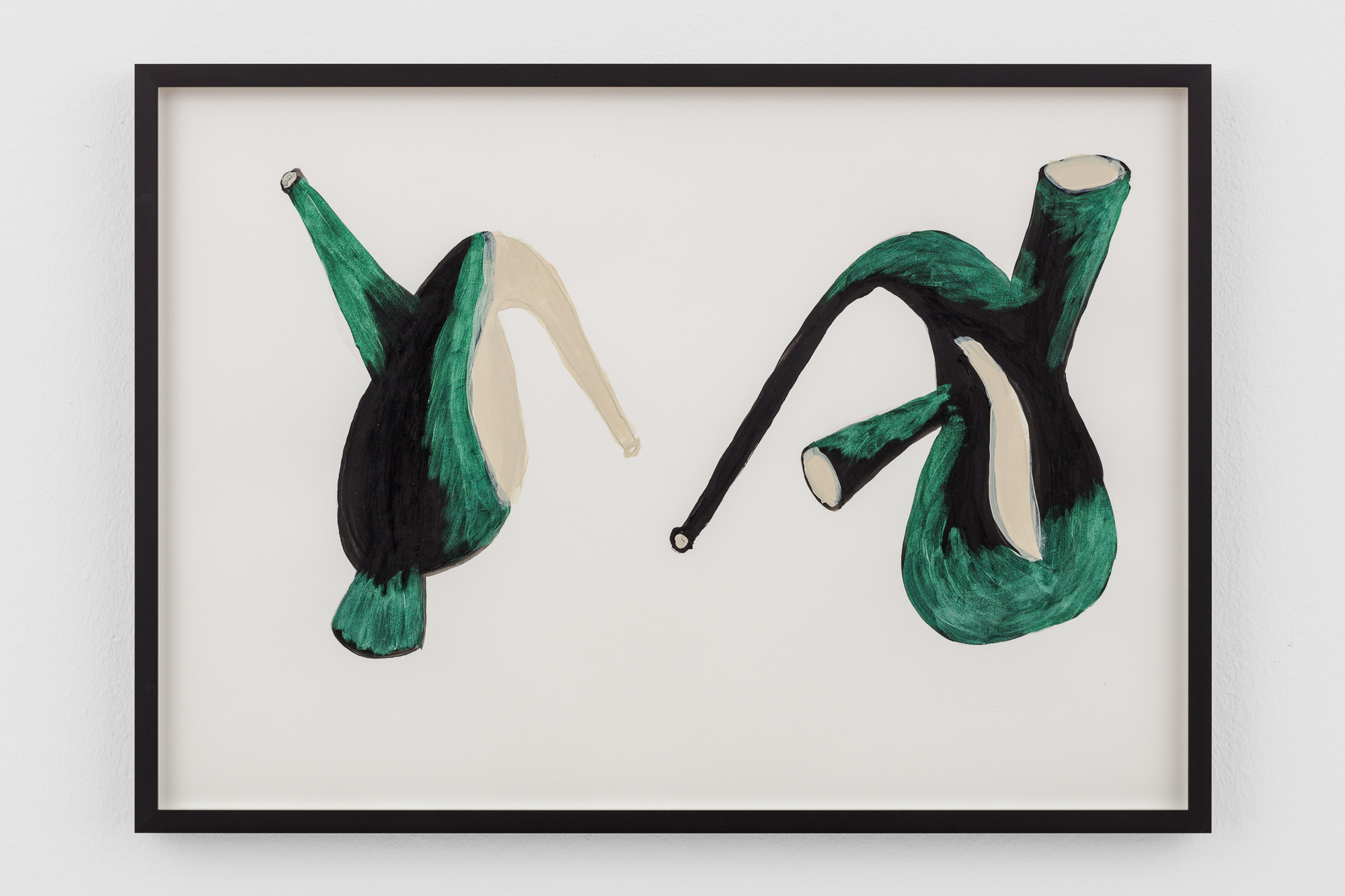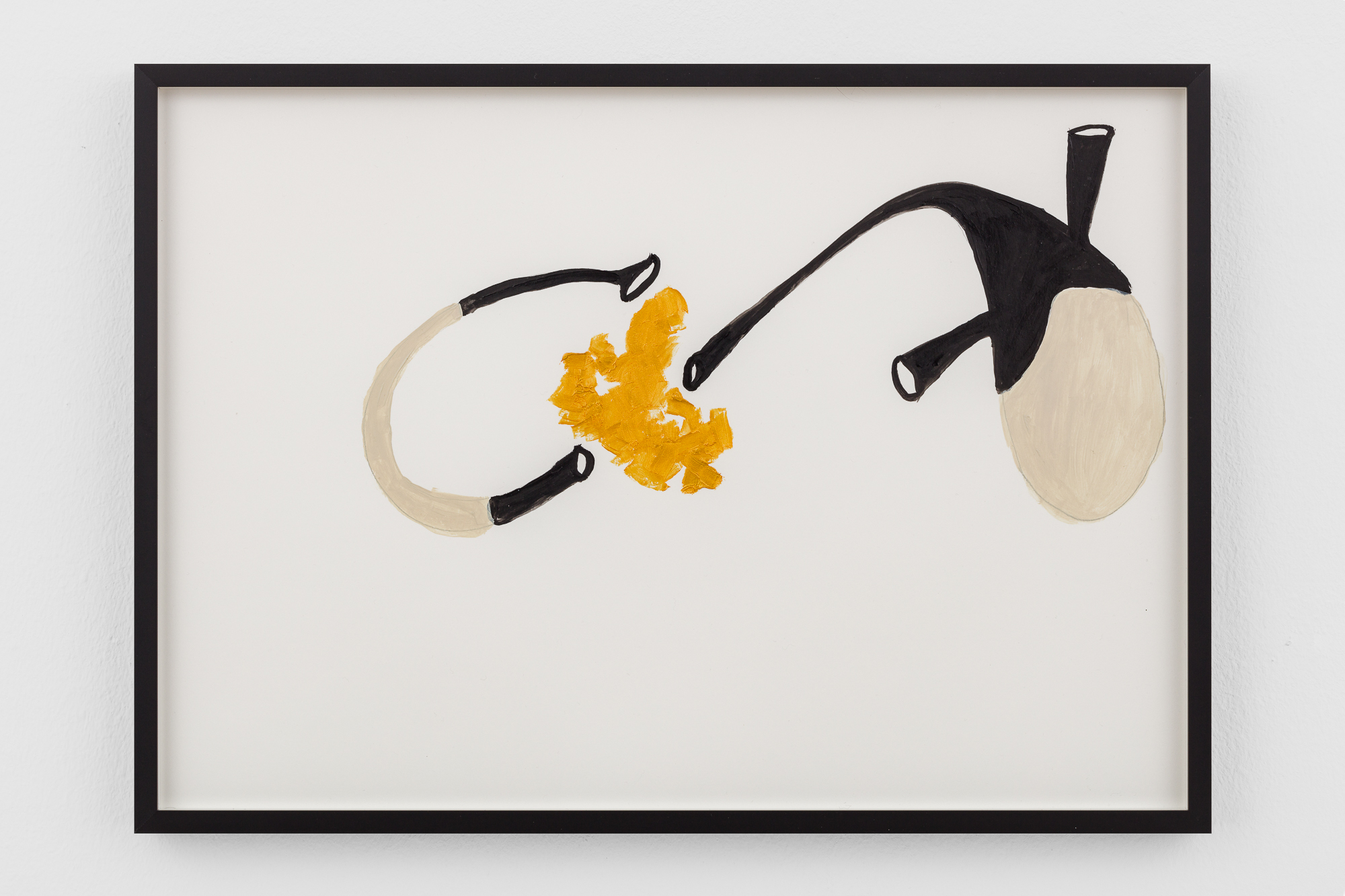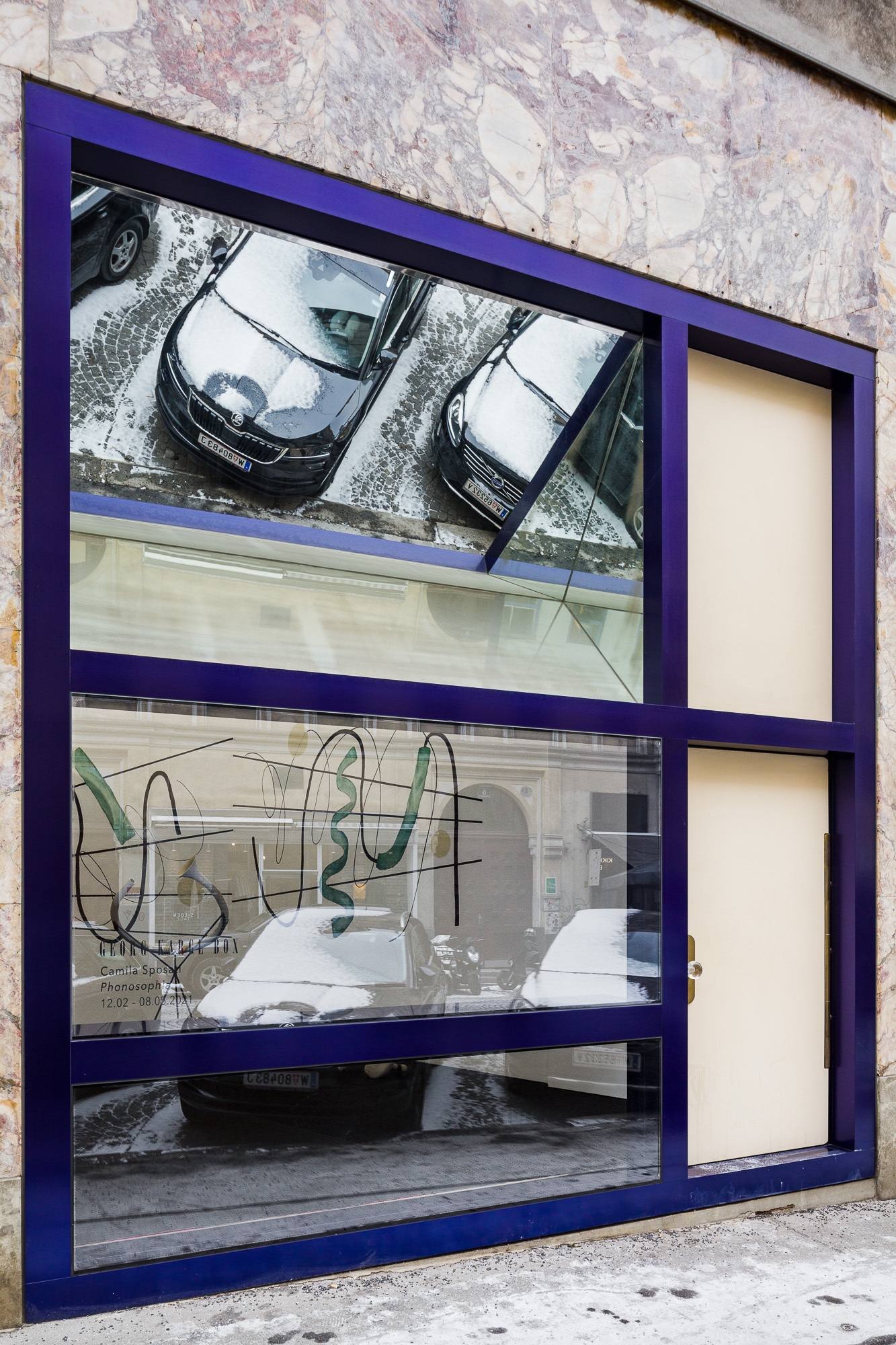—
Camila Sposati
Phonosophia
Mouths, Ears and Gravity
A reading of Camila Sposati’s Phonosophia by Aziza Harmel
“Sounds have curled up inside themselves, withdrawn their snail’s eyes; the orchestra of the world has departed, vanishing into the park.”
Olga Tokarczuk, Flights
Phonosophia as a project departs from Camila Sposati’s deep attention to the essence of interiority and stratification: the very center of the Earth as an unknown zone where lines of energy collide, creating gravity. She investigates transformation and energy transfers, using several epistemological systems to examine processes on both microscopic and global scales, such as the growth of crystals in laboratories and the dynamic geology of the Earth’s crust at different sites. This focus led to Sposati developing the Earth Anatomical Theatre which she built for the third Bahia Biennale in 2014. In order to speak of Phonosophia—which includes drawings, instruments, activations and scores—one needs to understand the Earth Anatomical Theatre. This temporary cone-shaped subterranean theater is inspired by the first anatomical theater ever built: the Anatomical Theatre at Palazzo Bo in the University of Padua. It was designed in 1594 by the anatomist Hieronymus Fabricius, the theologian Paolo Sarpi, and the architect and artist Dario Varotari the Elder, in order to allow for a maximum number of people to gather and watch the spectacle of dissecting the dead human body.
The act of digging this large hole in Bahia to build a theater (which was deconstructed, and the hole closed a year later) also points to the logic of extraction facilitated by colonial juridical mechanisms and structures of late capitalism. Mining is one of the major industries in the Brazilian economy, with disastrous consequences for the environment and the Amazonian indigenous, who have lived on these lands since precolonial times. Sposati acknowledges that the Earth remembers and embodies, and therefore a relationship exists between the anatomy of the Earth and the necessity of reflection on the interior, the organs of the Earth.
It is precisely in continuity with a reflection on this interiority that the instruments in Phonosophia were created. The relationship between the anatomical theater, the drawings and the instruments, must be understood through Sposati’s practice, specifically the way in which images and objects exist in a network of crossings between material, symbolic, and discursive lines.
The instruments evoke and invoke the structure and function of the human organs: guts, liver, larynx, lungs. Nevertheless, these objects are not self-referential but rather are subjects, just as the drawings are not representations of the instrument, but instead coexist with them both potentially and intentionally. Breaking away from one determined mode of perception, Sposati explores an understanding of the world mediated by different approaches to the body and its functions and reflects on how meaning circulates beyond wanting to know and not being able to comprehend.
This exhibition at Georg Kargl BOX happens to overlap with an exhibition at Kunsthalle Wien, titled Cybernetics of the Poor, where Sposati’s Phonosophia is also shown. In Cybernetics of the Poor, curated by Diedrich Diederichsen and Oier Etxeberria, some of Sposati’s instruments can be seen placed on a circular wooden platform, surrounded by a wall on which she has drawn scores for possible activations. What Sposati calls activation is a latent, visible or invisible interaction within the constellation of the work in a given context. Each element is a container for a potential future use. This potentiality goes far beyond what might possibly occur but serves as an acknowledgement of the constant flow of energies around us. The activation creates a setting for this flow that is neither random nor predetermined. This dialogue also occurs between the two bodies of work presented in the two exhibitions, taking place in two different spaces in the same city. Beyond any metaphorization, they activate each other.
Phonosophia establishes relations between the voice and transmission through the exteriorizing living and thinking. The form of the object is made up of three parts: mouths, ears, and gravity. These three elements are interconnected and yet differ in their connection to the Western instrument. For instance, Sposati’s trumpet has no valves, therefore there is only one tone. It is not virtuosity that is at stake here, but rather the intention and the intensity of blowing through the instrument and the kind of exteriorization that will take place. The instruments can be activated for multiple people, some are also designed to be played back to the person who activates them, yet they all highlight the potentiality to be heard from within the instrument itself.
When talking about the instruments, one is tempted to use the notion of animism, but instead I will focus on a central notion in the work of Sposati, which is intention. The shape of the instrument is not defined by the sound that it will produce, but by the intention of the artist and by what the material with which she works with allows her to achieve. She uses clay as a malleable matter and this act of making and interacting with it is crucial to the artist. She deals with heat and humidity, transformation, and energy. Throughout the whole process—intimate and fragile—the clay can be understood as a membrane through which a concrete transfer of energies takes place. The material is animated by its own porous viscosity, becoming a site of exchange, a membrane through which content and potentiality of content circulate.
In her text Hydrofeminism: Or, On Becoming a Body of Water, Astrida Neimanis discusses this idea of the membrane, mentioning Nancy Tuana’s use of the term “viscous porosity.” Neimanis states that “[w]hile the concept of fluidity emphasizes traversals across and between bodies, viscosity reminds Tuana that there are still bodies—all different—that need to be accounted for. Viscosity draws attention to ‘sites of resistance and opposition’ rather than only ‘a notion of open possibilities’ that might suggest one indiscriminate flow. Despite the fact that we are all watery bodies, leaking into and sponging off of one another, we resist total dissolution, material annihilation. Or more aptly, we postpone it: ashes to ashes, water to water.” Sposati would probably add to this: earth to earth, Earth’s Earth.
The paint that Sposati uses in her drawings of the instruments, shown for the first time in this exhibition, is also viscous both in its matter and in the indeterminacy of its color. In fact, she often uses iridescent paint, which appears to gradually change color as the angle of view or the angle of illumination changes. Iridescence is caused by differential refraction of light waves like on soap bubbles or on certain feathers. The indeterminacy of the colors used to draw the instruments is also the result of the artist’s resistance to representing them.
These interconnections between all the elements in Sposati’s work are the result of the concrete, yet invisible, transfers of experience throughout the artist’s practice, conceptually and bodily. Within Western politics of the gaze and image there is the assumption that the visible is what exists and the invisible, by contrast, is what does not exist. This action of scission between the two is not natural. It is a construction emanating from historical and social struggles. Phonosophia breaks away from this scission, drifting towards an encounter between several bodies that will react and expand through each other.
Not exactly as a goal, but as an exploration and a deep attention to what happens within and as a reflection on the mediation between the instrument and its surroundings.
Biography
born in 1972 in São Paulo, lives and works in Vienna
Selected Solo Exhibitions
2025
MINERAL AS MUSICAL NOTE, performance, Natural History Museum, Vienna
From Within, Beneath and Beyond: Through Matter, Lombardi—Kargl, Vienna
2024
Coal, HOAST, Vienna
2023
Breath Pieces (Part II), ifa-Galerie, Berlin
Breath Pieces, ifa-Galerie, Stuttgart
2021
Corpos de Phonosophia, Residência Belojardim, Pernambuco
Phonosophia, Georg Kargl BOX, Vienna
2018
Phonosophia, Goethe Institut - na Vila Itororó, São Paulo
2015
Glory Hole, São Paulo
2013
Earth’s Earth, Eleven Rivington Gallery, New York, USA
2012
When 2+2=0, Die Raum, Berlin
Green-Dyed Vulture, HICA-Highland Institute of Contemporary Art, Achnabat, Inverness
Darvaza, Casa Triângulo, São Paulo
Charting Revolution, Centro Cultural Montehermoso, Vitoria-Gasteiz
2011
Rescue Submarine Signal, Die Raum, Berlin
Gabion, Centro Universitário Maria Antonia, Sao Paulo
2009
Nucleation, Casa Triângulo, São Paulo
2007
Rescue Smoke, Paço das Artes, São Paulo
2001
The BBQ, Berlin
Selected Group Exhibitions
2025
CORPUS COSMOS, Uppsala Konstmuseum, Uppsala
2024
Nós - Arte e Ciência por Mulheres, SESC Interlagos, São Paulo
My memory isn´t mine, Krupa Art Foundation, Poland
Bringing Owls from Athens, Georg Kargl BOX x Callirrhoë, Athens, Georg Kargl BOX, Vienna
Body at Play, Georg Kargl BOX, Vienna
2023
HARD/SOFT. Textiles and Ceramics in Contemporary Arts, MAK, Vienna
Here and Now II - Vienna Sculpture 2023, Neuer Kunstverein Wien, Vienna
37° Panorama da Arte Brasileira, Under the ashes, embers, Sesc, Sorocaba
We - Art and Science by women, Paco da Artes,São Paulo
Precious, Georg Kargl Fine Arts, Vienna
2022
trauma, dreams escape,13th Bienal do Mercosul, Porto Alegre
The devil to pay in the backlands, Neuer Kunstverein Wien, Vienna
37° Panorama da Arte Brasileira, MAM, São Paulo
2021
Sorry It´s a Mess, We Just Moved In!, Lamb Gallery, London
Cybernetics of the Poor, Tabakalera, San Sebastian, Kunsthalle Wien, Vienna
2019
Echos of South Atlantic, Pivô arte e pesquisa, Galeria Athena, Rio de Janeiro
Belo Monte, Pernambuco, Brazil
2018
#elenão, LAMB Arts, London
Museu dos Futuros Possíveis, Centro Internacional de Convenções do Brasil/ SESI-Vitoria do Espírito Santo
Echos of South Atlantic, Goethe Institut, Salvador
Museu José Bonifácio, Rio de Janeiro
2017
The sky is still blue, you know…, Instituto Tomie Ohtake, São Paulo
To Seminar, BAK. basis voor actuele Kunst, Utrecht
2016
The Earth Anatomical Theatre, Teatro Vila Velha, Salvador
2015
10th Bienal do Mercosul, Porto Alegre, Brazil
Perception of art and Science, Centro Cultural Banco do Brasil, Rio de Janeiro
The garden of forking paths, Sobering Galerie, Paris
2014
3th Bienal da Bahia, MAM-Bahia e Museu de Arte Sacra, Salvador
Manifesto: poder, desejo, intervençã, Museu de Arte do Rio Grande do Sul Ado Malgoli–MARGS, Porto Alegre
Geografias da Criação, Museu de Arte do Rio Grande do Sul Ado Malgoli– MARGS, Porto Alegre
Arte e Patrimônio 2014, Paço Imperial, Rio de Janeiro
Neblina, Museu de Arte Contemporânea do Rio Grande do Sul – MACRS, Usina do Gasômetro, Porto Alegre
Janeiro, Bendana-Pinel art contemporain, Paris
2013
Arte e Design, Torre Santander, São Paulo
Reforma e reivenção, Museu de Arte da Bahia-MAMBA, Salvador
Video Selection, Galerie Joseph Tang, Paris
Correspondências, Instituto Tomie Ohtake, São Paulo
2012
Cibles, Musée de la Chasse et de la Nature, Paris
Outra generacion, Blanca Soto, Madrid
Cromomuseu. Pós-Pictorialismo no Contexto Museológico, Museu de Arte do Rio Grande do Sul Ado Malgoli– MARGS, Porto Alegre
2011
Album, Galeria Baró, São Paulo
RAW - Lustwarande’11 - 4th Edition International Sculpture Exhibition, Tilburg
2010
Multiplique Boutique, Galeria Mendes Wood, São Paulo
Editions, Casa Triângulo. São Paulo
The Great Glen Artist Airshow, Highland Institute of Contemporary Art – H I. C A, Inverness-Hire
2009
Void of Memory, Platform in KIMUSA of Platform 2009, Seoul
Scream and Listen, 7th Mercosul Biennale, Porto Alegre
2008
Open studio, Tokyo Wonder Site, Tokyo
Active Forms, Eleven Rivington Gallery, New York
Form Instability, Institute of Brazilian Architects, São Paulo
Artist links, Centro Cultural Sao Paulo, São Paulo
2007
Crystal Growth /Opening Studio, Gasworks, London
Comunismo da Forma: Som + Imagem + Tempo - Estratégia do Vídeo Musica, Galeria Vermelho, São Paulo
Video Links Brazil: na antohology of Brazilian Video Art. 1981-2005, Tate Modern, London
Living Level, Absolute Vodka-Sparte, São Paulo
2006
Convergência, Galeria Del Infinito Arte, Buenos Aires
Certamen Internacios de Artes Plasticas de Pollença, Museu de Pollença, Mallorca
Neobarroco, Galeria Leme, São Paulo
Videometry, Galeria dels Angèls, Barcelona
Vizinhos /networked art in Brazil, MuseumsQuartier, Vienna
7º Salão do Mar, Casa Porto das Artes Plásticas, Vitória do Espírito Santo
Laisle entertainment – Video as Urban Condition, Paço das Artes, São Paulo
Paris é aqui, São Paulo
LATAM, Fundación Telefónica, Lima
Aderências, SESC Paulista, São Paulo
Paralela 2006, Pavilhão dos Estados, São Paulo
2005
Além da imagem, Centro Cultural Telemar, Rio de Janeiro
Prog: ME, Centro Cultural Telemar, Rio de Janeiro
El sutil Vertigo de la Imagen, Centro Cultural Parque de España, Rosário
Aderências- Mediterrâneo, SESC Paulista, São Paulo
Sex frjó egg, Woollenmaiden ProjectSpace, Reykjavik
Brief Encounter, 12 de maio de 2005, ReykjavikurAkademian, Reykavik
Portrait, Galeria Leme, São Paulo
Ocupação, Paço das Artes, São Paulo
2004
Exposição n.1, Galeria Leme, São Paulo
Fluxo de Arte Belém Contemporâneo, Museu de Arte de Belém (MABE) e Memorial dos Povos, Belém do Pará
Mostra de Video Paulista, Espaço Bananeiras, Rio de Janeiro
Cine Quintal n.1, Exo experimental, São Paulo
Framing Devices, The Agency gallery, London
Goldsmiths College Graduates 2003, Mirko Mayer Gallery, Cologne
2003
Insert, Cuchifritos Essex Street Market, New York
Take me seriously, Apriori Gallery, London
Made in UK, Arch Gallery, London
Dörgicsewineart, Pántlika Borház, Budapest
2002
The island and the aeroplane, Sparwasser HQ, Berlin
X Salão de Arte de Goiá, Shopping Flamboyant, Goiania
April’s Fool, São Paulo
E(x)tra Bienal, São Paulo
2001
Chuckoo chuckoo chukoo, Auckland Art Gallery, Auckland
Lovesick, Bergens Kunstforening, Bergen
Future Perfect, Adam Street Gallery, London
Landscape Trauma in the age of scopophilia, The Gallery-Southward Park, London
Unchaperoned, Aroma Project Space, Berlin
Pandemonium Festival, Lux Cinema, London
EV+A - 25th Annual Exhibition of Visual Art, Limerick City Gallery, Limerick
Glamourhammer, Boxing Ring Samuel Becket, London
2000
Assembly, Stepney City, London
Pourquoi, Moulin de Heutrégiville, Reims
Living with a Dutch, House Project, Enlarger Road, London
Chroma, Mercado de Fuencarral, Madrid
Shotgun, Udstillingsstedet Peblinc, Copenhagen
Cool, Elephant and Castle House project, London
Rooftopp, 17th Star & Garter mansions -Putney, London
Degree Show, Goldsmiths College of London, London
Landscape, Institut of Contemporary Art- ICA - video projection: Leicester Sq., Convent Garden e Festival Edinburgh
non stop opening, Galeria Zé dos Bois, Lisbon
1999
non stop opening, Central Point Gallery, London
1996
Novíssimos, Galeria Fotótica, São Paulo
Videos
Inquiry
Please leave your message below.
